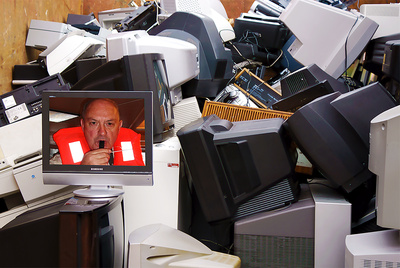The EU has identified 20 critical raw materials, including indium, with economic importance and a high supply risk. Indium is mainly used for the production of LCD screens and is predominantly sourced from Chinese mines. This study, funded by the European Commission1 , details the development of a process to recycle indium from waste LCD panels, where indium is found as indium tin oxide (ITO). The study is one of the first to describe how to recover indium from a leaching solution of waste LCD panels. Developing methods to recover materials from waste equipment is an important way of saving resources and reducing primary production of materials.
The researchers recovered indium from waste LCD panels through cementation: the process by which a solid is created from a solution. The panels were first shredded into small pieces and sieved to remove glass and plastic fragments, then indium was dissolved in a strong acid solution. Zinc metal powder was used in the solution to collect the indium, which becomes solid by reacting with zinc during the cementation process.
The study was undertaken in order to identify the best operating conditions under which to recover indium from a solution that contains other metals; 16 experimental treatments were used to investigate the effect of variations in zinc concentration, pH of the acid solution and the duration of the recovery process. An important goal of the process is to ensure that the maximum possible yield of high-purity indium can be obtained from ITO.
The environmental impact of the indium recovery process was also assessed through life-cycle assessment (LCA). The LCA was undertaken to identify the environmental benefits and impacts of recovering indium using this method, in terms of the loss of (non-living) natural resources and global-warming impacts. Indium recovery from waste LCD panels was compared with incineration and use of landfills, which are the current methods of LCD waste disposal.
The highest indium recovery (99.8%) using an acid solution with a pH of 2 was achieved when a relatively high concentration of zinc was used (100 grams per litre, g/L). Overall, the best results for indium recovery were found using a solution with an acidity of pH 3, which led to high recovery of indium even at low concentrations (5 g/L) of zinc. The percentages of indium recovery at pH 3 were: 98.0% with a low concentration of zinc (2–5 g/L), from 95.0% to 98.9% with a medium concentration of zinc (15–20 g/L) and 99.9% with a high concentration of zinc (100 g/L).
Although the highest recovery rates were achieved using the highest concentrations of zinc, carrying out indium cementation with less zinc is more resource-efficient.
In order to gain indium in its purest possible form it was necessary to allow cementation for 10 minutes. A longer cementation time resulted in an increase of impurities, including aluminium, calcium and iron, relative to the indium. Statistical analysis confirmed that a higher pH, a longer recovery process and higher concentrations of zinc all had a positive impact on the efficiency of the recovery process, but longer recovery times increased the level of impurities in the recovered product.
The LCA indicated that, in general, indium recovery from waste LCDs has environmental benefits when compared to landfill or incineration options. Incineration had the highest costs in terms of global-warming impacts. Indium recovery also had a net environmental benefit in relation to natural resource depletion.
The study demonstrates a method to recycle indium from end-of-life LCDs rather than mining from natural reserves, which will be valuable for industries and researchers working in critical raw materials recovery. The study also supports the development of effective strategies for the recovery of secondary indium in Europe (relevant to the EU Directive on waste electrical and electronic equipment2), with resulting benefits of decreasing dependency on imports from other countries.







